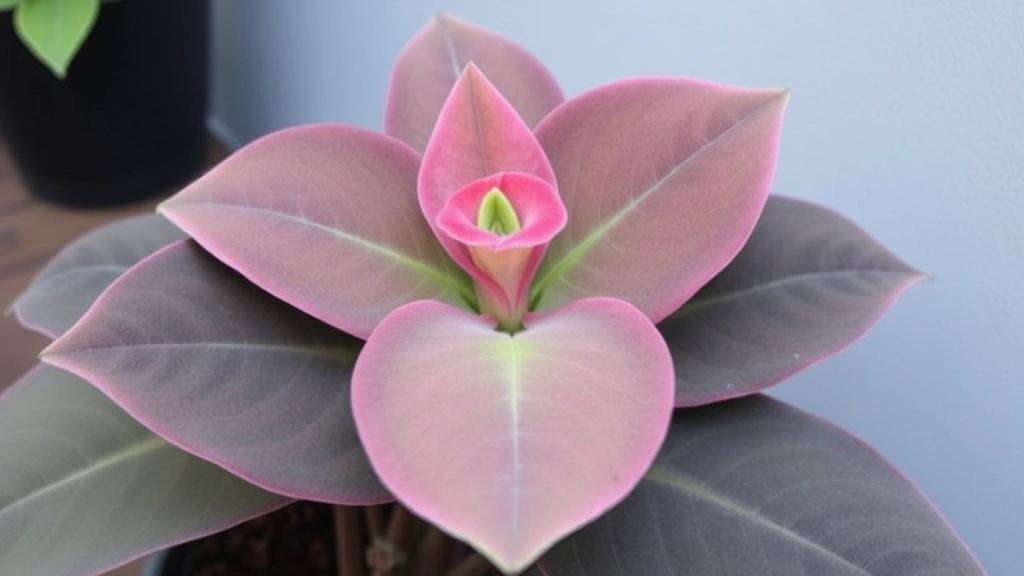Kalanchoe Beharensis Velvet Elephant Ear
If you’re looking to add a touch of exotic flair to your home garden, the Kalanchoe Beharensis Velvet Elephant Ear is a fantastic choice. This unique succulent, known for its velvety leaves and striking appearance, is not only easy to care for but also a conversation starter. In this guide, I’ll walk you through the steps to create the perfect environment for your Kalanchoe Beharensis to thrive.
Ideal Conditions
First, let’s talk about the ideal conditions for this plant. The Velvet Elephant Ear prefers bright, indirect sunlight and well-draining soil. Watering should be done sparingly, allowing the soil to dry out completely between waterings. By following these simple guidelines, you’ll ensure your Kalanchoe Beharensis remains healthy and vibrant all year round.
Overview of Kalanchoe Beharensis
Are you looking for a unique and resilient plant to add to your collection?
Kalanchoe Beharensis, commonly known as the “Chandelier Plant,” is a striking succulent that has captured the hearts of many plant enthusiasts.
This captivating species is native to Madagascar and is renowned for its distinctive, elongated leaves that can grow up to 30 cm long, giving it a sculptural appearance.
The leaves are typically grey-green and may have a velvety texture, making them not only visually appealing but also a conversation starter among plant lovers.
Kalanchoe Beharensis is a part of the Crassulaceae family, which includes many other popular succulents.
One of the best features of this plant is its ability to thrive in a variety of conditions, making it an excellent choice for both novice and experienced gardeners. For more details on how to care for this plant, check out our essential tips guide.
If you’re concerned about care requirements, don’t fretâthis plant is relatively low-maintenance. Additionally, if you’re interested in other unique Kalanchoe varieties, you might want to explore the top succulent Kalanchoe types for your garden.
II. Physical Characteristics of Kalanchoe Beharensis
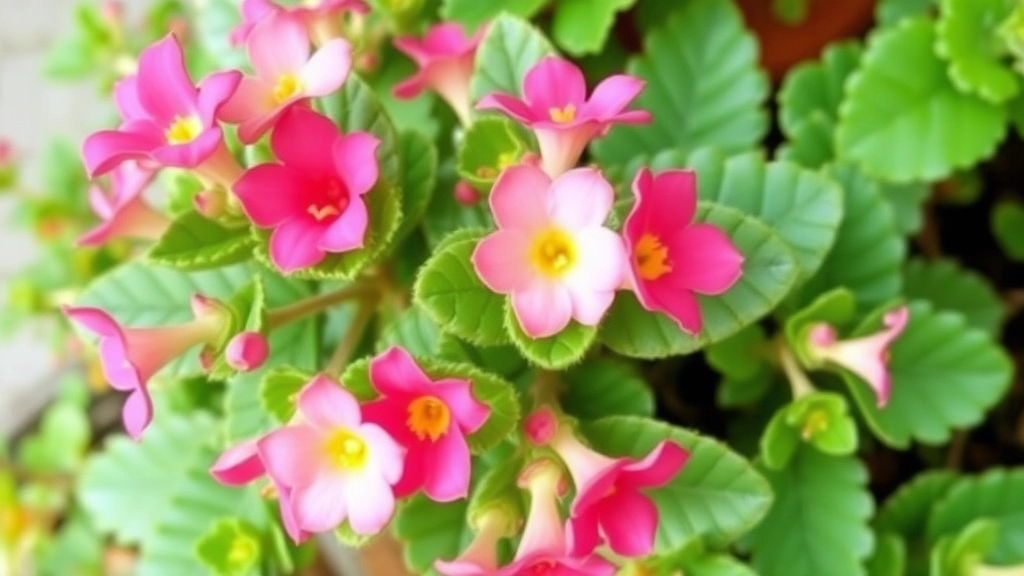
So, you’ve got your eye on Kalanchoe Beharensis, huh? Great choice! But what makes this succulent stand out? Let’s dive into its physical traits.
Size and Shape
Kalanchoe Beharensis, also known as the “Chandelier Plant,” is a striking succulent that can grow up to 1 meter tall.
- Leaves: Its leaves are thick, fleshy, and often have a unique, elongated shape. They can grow up to 15 cm long and 7 cm wide, sporting a lovely grey-green hue.
- Stems: The stems are sturdy and can branch out, giving it a bushy appearance.
Texture and Colour
One of the most captivating features is its texture.
- Leaf Surface: The leaves have a slightly waxy feel, helping them retain moisture.
- Colour Variations: Sometimes, you’ll notice a hint of a reddish tint, especially if the plant is exposed to bright light.
Flowers
When it blooms, Kalanchoe Beharensis produces clusters of small, tubular flowers that are usually yellow or orange.
- Blooming Period: Typically, it flowers in late winter to early spring, adding a splash of colour to your space.
Overall Aesthetic
This plant has a unique, architectural look that can really elevate your indoor or outdoor garden.
- Versatile: Whether you place it on a windowsill or in a garden bed, its bold presence won’t go unnoticed.
Ideal Growing Conditions for Kalanchoe Beharensis
When it comes to nurturing Kalanchoe Beharensis, understanding its ideal growing conditions can make a significant difference in its health and vibrancy. Many plant enthusiasts often wonder about the best environment for this stunning succulent.
Temperature and Humidity
Kalanchoe Beharensis thrives in warm climates.
- Temperature Range: Ideally, keep it between 20°C to 30°C (68°F to 86°F). For more details, check out the Optimal Kalanchoe Temperature Range Guide.
- Humidity: This plant prefers low to moderate humidity levels, making it perfect for indoor environments.
Placement
Choosing the right spot for your Kalanchoe Beharensis is crucial.
- Indoor Locations: A south-facing window is ideal, as it provides ample sunlight. Learn more about whether Kalanchoe can thrive in shade.
- Outdoor Settings: If you’re thinking of planting it outside, ensure it’s in a sheltered area that avoids harsh winds.
Air Circulation
Good airflow is essential for preventing fungal issues.
- Ventilation: Make sure the area is well-ventilated to keep the plant healthy.
Soil and Potting Requirements
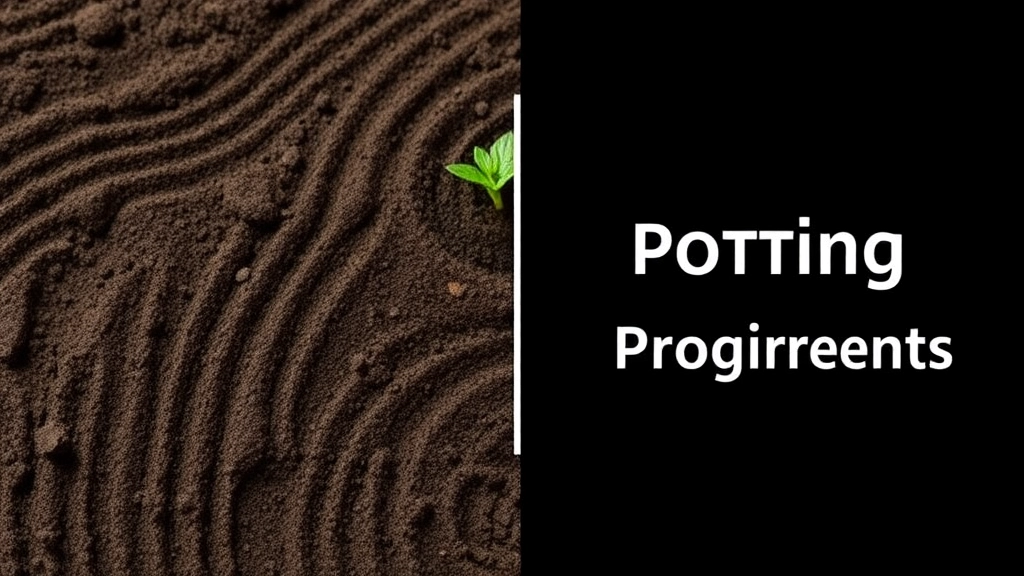
When it comes to cultivating Kalanchoe Beharensis, selecting the right soil and potting conditions can significantly influence its growth and health. Many plant enthusiasts often wonder what kind of soil will suit this succulent best.
Soil Composition
Kalanchoe Beharensis thrives in well-draining soil. Here are some key points to consider:
- Cactus Mix: A commercial cactus or succulent mix is ideal, as it offers excellent drainage.
- Homemade Blend: You can create your own mix using:
- 50% potting soil
- 25% perlite or pumice
- 25% coarse sand
This combination ensures that excess moisture drains away quickly, preventing root rot.
Potting Considerations
Choosing the right pot is equally crucial. Here’s what to keep in mind:
- Drainage Holes: Always select a pot with drainage holes to allow excess water to escape.
- Size: A pot that is slightly larger than the root ball is perfect. This provides room for growth without retaining too much moisture.
- Material: Terracotta pots are a great option as they are porous and allow for better airflow to the roots.
Repotting Tips
It’s essential to repot your Kalanchoe Beharensis every couple of years or when it outgrows its pot. Here’s how to do it smoothly:
- Choose the Right Time: Spring is the best time for repotting.
- Gently Remove the Plant: Carefully take the plant out of its current pot without damaging the roots.
- Inspect the Roots: Trim any dead or damaged roots before placing it in fresh soil.
By ensuring your Kalanchoe Beharensis has the right soil and potting conditions, you set the stage for a thriving plant.
Watering Needs
When caring for your Kalanchoe Beharensis, understanding its watering needs is crucial for its health and vitality.
Many plant enthusiasts often wonder how much water is too much or too little for their succulents.
Key Watering Guidelines
- Frequency: Water your Kalanchoe Beharensis every 2-3 weeks during the growing season (spring and summer). In the dormant months (fall and winter), reduce watering to once a month.
- Method: Always water deeply but infrequently. Ensure the water reaches the root zone without waterlogging the plant.
- Soil Check: Before watering, check the top inch of the soil. If it’s dry, it’s time to water. If it’s still moist, hold off for a few more days.
- Drainage: Ensure your pot has drainage holes. This prevents water from accumulating at the bottom, which can lead to root rot.
Signs of Overwatering
Keep an eye out for these signs that may indicate your Kalanchoe Beharensis is receiving too much water:
- Yellowing leaves
- Wilting despite wet soil
- Mushy or translucent leaves
Conversely, if you notice shrivelling leaves, it may be a sign of underwatering.
By following these simple guidelines, you can keep your Kalanchoe Beharensis thriving. For more detailed care tips, check out our care tips for a fully grown Kalanchoe plant. Additionally, if you notice any unusual changes in your plant, such as yellowing leaves, you may want to explore our guide on why Kalanchoe bottom leaves turn yellow.
Light Requirements
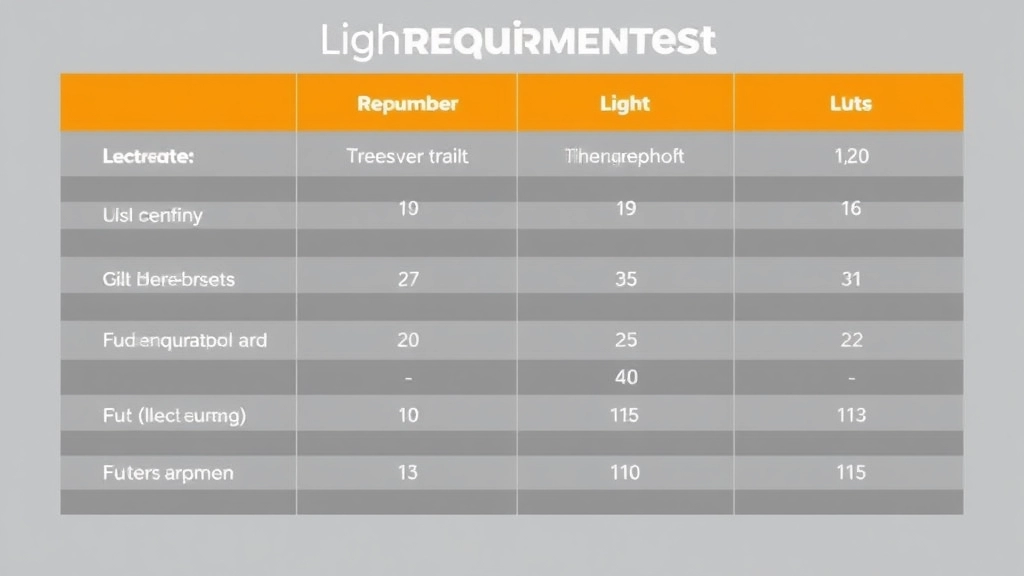
So, you’ve got your Kalanchoe Beharensis and you’re wondering how much light it needs to thrive, right?
Well, you’re in the right spot!
This succulent is a real sun lover, so let’s break it down.
Optimal Light Conditions:
- Bright Indirect Light: Kalanchoe Beharensis flourishes in bright, indirect sunlight. Think of a sunny windowsill that doesn’t get blasted by harsh rays.
- Direct Sunlight: While it can handle some direct sun, too much can scorch those lovely leaves. A couple of hours in the morning or late afternoon is ideal.
- Low Light: If your space is a bit dim, don’t fret! It can tolerate low light but won’t grow as vigorously.
Signs Your Plant is Happy:
- Vibrant Colour: If the leaves are a rich green, you’re doing great.
- Stretching: If it starts stretching towards the light, it’s a sign it’s craving more.
Tips for Placement:
- Rotate Your Plant: Every few weeks, give it a gentle twist to ensure even light exposure.
- Watch the Seasons: In winter, you might need to move it closer to the window as days get shorter.
Common Pests and Diseases
As we delve deeper into caring for Kalanchoe Beharensis, it’s essential to address a common concern: pests and diseases.
Pests to Watch For
Kalanchoe Beharensis, while generally resilient, can attract a few unwelcome guests. Here are the most common pests you might encounter:
- Mealybugs: These tiny, white, cotton-like insects can cluster on leaves, sucking sap and weakening the plant.
- Aphids: Small and often green or black, aphids can cause distorted growth and yellowing leaves.
- Spider Mites: These minuscule pests thrive in dry conditions, leaving fine webs and causing stippling on leaves.
Diseases to Be Aware Of
In addition to pests, Kalanchoe Beharensis can be susceptible to certain diseases:
- Powdery Mildew: This fungal disease appears as a white powdery coating on leaves, often caused by high humidity and poor air circulation.
- Root Rot: Overwatering can lead to root rot, a serious condition that can kill your plant. Look for wilting or yellowing leaves as warning signs.
Prevention and Treatment
To keep your Kalanchoe Beharensis healthy, consider these preventive measures:
- Regular Inspections: Check your plant regularly for signs of pests or diseases.
- Proper Watering: Ensure you’re not overwatering. Let the soil dry out between waterings.
- Good Air Circulation: Place your plant in a well-ventilated area to prevent fungal issues.
If you do spot pests, act quickly:
- Insecticidal Soap: This can be effective against mealybugs and aphids.
- Neem Oil: A natural remedy that can deter a variety of pests and help with fungal issues.
For more detailed care instructions, you might find our Kalanchoe Beharensis Care Guide helpful. Additionally, if you’re dealing with watering issues, our guide on how to water a Kalanchoe can provide some useful tips.
Propagation Methods for Kalanchoe Beharensis
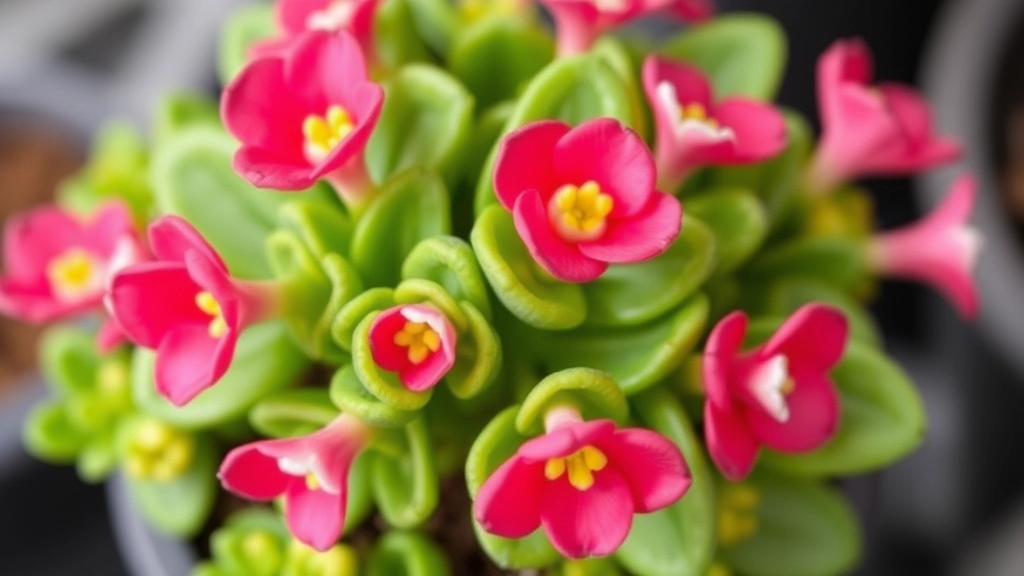
So, you’re looking to multiply your Kalanchoe Beharensis? Great choice! This succulent is not only stunning but also super easy to propagate. Let’s dive into some straightforward methods to get you started.
Leaf Cuttings
One of the simplest ways to propagate your Kalanchoe Beharensis is through leaf cuttings. Here’s how:
- Choose a Healthy Leaf: Pick a plump, healthy leaf from your plant.
- Cut It Off: Use a clean, sharp knife to cut it at the base.
- Let It Callous: Place the leaf in a dry spot for a few days. This helps prevent rot.
- Plant It: Once calloused, lay it on top of well-draining soil and lightly press it down.
- Water Sparingly: Just a mist will do until you see new growth.
Offsets
If your Kalanchoe Beharensis has produced offsets (little pups), you can easily propagate these:
- Locate the Offsets: Look around the base of the plant for small offsets.
- Gently Remove: Use your fingers or a small tool to carefully detach them from the main plant.
- Let Them Dry: Allow them to dry out for a day or two.
- Plant: Place them in their own pots with succulent soil.
- Water: Again, keep it light until you see new growth.
Seed Propagation
If you’re feeling adventurous, you can also try growing Kalanchoe from seeds:
- Get Seeds: Purchase seeds from a reliable source.
- Prepare Soil: Use a seed-starting mix that drains well.
- Sow Seeds: Sprinkle seeds on the surface and lightly cover them with soil.
- Water Gently: Mist the soil to keep it moist but not soggy.
- Provide Light: Place under a grow light or in a bright spot.
Tips for Success
- Timing: Spring is the best time for propagation.
- Humidity: A little humidity can help, especially for leaf cuttings.
- Patience: It may take a few weeks to see results.
As we delve deeper into caring for your Kalanchoe Beharensis, it’s essential to consider how seasonal changes can impact its growth and health. Many plant enthusiasts often worry about how their plants will fare through the varying conditions of each season.
### Spring Care
– **Repotting**: This is the ideal time to repot your Kalanchoe. Choose a slightly larger pot to allow for growth.
– **Fertilisation**: Start feeding your plant with a diluted succulent fertiliser every four to six weeks.
– **Pruning**: Trim away any dead or damaged leaves to encourage new growth.
### Summer Care
– **Watering**: Increase watering frequency as temperatures rise, but ensure the soil dries out between waterings.
– **Pest Monitoring**: Keep an eye out for pests, as they can thrive in warmer weather. Regularly inspect the undersides of leaves.
– **Sun Exposure**: Ensure your plant receives plenty of bright, indirect sunlight to prevent leaf scorch.
### Autumn Care
– **Water Adjustment**: Reduce watering as temperatures begin to drop. Your Kalanchoe will enter a semi-dormant phase.
– **Temperature Control**: Keep the plant in a warmer area, as cooler temperatures can stress it.
– **Cleaning**: Dust leaves gently to maximise light absorption.
### Winter Care
– **Light Needs**: Place your Kalanchoe near a south-facing window to ensure it gets adequate light.
– **Minimal Watering**: Water sparingly, allowing the soil to dry out completely before the next watering.
– **Humidity**: Avoid placing your plant near heating vents, as dry air can lead to issues.
For more detailed guidance, check out our [Elephant Ear Kalanchoe Beharensis Care and Propagation Guide](https://planthq.org/elephant-ear-kalanchoe-beharensis-care-and-propagation-guide/) and learn about the [Medicinal Properties and Health Benefits of Kalanchoe](https://planthq.org/kalanchoe-medicinal-properties-health-benefits-uses/).
Benefits and Uses of Kalanchoe Beharensis
So, you’ve got a Kalanchoe Beharensis and you’re wondering what makes this succulent so special?
Let’s dive into its benefits and uses!
1. Aesthetic Appeal
Kalanchoe Beharensis, often called the “Chandelier Plant,” is a showstopper.
With its stunning, large, fleshy leaves, it adds a unique touch to any space.
Whether you’re sprucing up your home or office, this plant is a fantastic conversation starter.
2. Air Purification
Did you know that certain plants can help clean the air?
Kalanchoe Beharensis is known to filter out toxins, making your environment healthier.
This is a great perk if you’re living in a busy city or just want to breathe easier at home.
3. Low Maintenance
If you’re like me, you don’t want a plant that demands constant attention.
Kalanchoe Beharensis is perfect for busy folks.
It thrives on minimal care, making it ideal for beginners or anyone who might forget to water now and then.
4. Medicinal Uses
While not widely known, some cultures use Kalanchoe for its medicinal properties.
It’s believed to have anti-inflammatory and antibacterial qualities.
Just remember, always consult a healthcare professional before using any plant for medicinal purposes.
5. Propagation Opportunities
If you love sharing plants, Kalanchoe Beharensis is a dream.
You can easily propagate it through leaf cuttings or offsets.
This means you can share the love with friends and family, or even start your own mini garden.
6. Versatile Decor
From hanging baskets to tabletop displays, this plant fits in anywhere.
You can get creative with how you showcase it, adding character to your living space.
For more detailed care tips, check out our Kalanchoe Beharensis Care Guide and learn how to make your plant thrive. Also, don’t miss our comprehensive guide on Chandelier Plant care for more insights.
FAQs About Kalanchoe Beharensis (Velvet Elephant Ear)
What is Kalanchoe Beharensis?
Kalanchoe Beharensis, also known as the “Chandelier Plant” or “Velvet Elephant Ear,” is a striking succulent that can grow up to 1 meter tall. It is known for its thick, fleshy leaves and unique, architectural look.
What are the key physical characteristics of Kalanchoe Beharensis?
This plant features thick, elongated leaves that can grow up to 15 cm long and 7 cm wide. The leaves have a grey-green hue and sometimes a reddish tint. The stems are sturdy and can branch out, giving the plant a bushy appearance. It also produces clusters of small, tubular flowers that are usually yellow or orange.
What type of soil is best for Kalanchoe Beharensis?
Kalanchoe Beharensis thrives in well-draining soil. A commercial cactus or succulent mix is ideal. You can also create your own mix using 50% potting soil, 25% perlite or pumice, and 25% coarse sand.
What kind of pot should I use for Kalanchoe Beharensis?
Choose a pot with drainage holes to allow excess water to escape. A pot that is slightly larger than the root ball is perfect. Terracotta pots are a great option as they are porous and allow for better airflow to the roots.
How much light does Kalanchoe Beharensis need?
Kalanchoe Beharensis flourishes in bright, indirect sunlight. It can handle some direct sun, preferably in the morning or late afternoon, but too much can scorch the leaves. It can tolerate low light but won’t grow as vigorously.
How do I propagate Kalanchoe Beharensis?
You can propagate Kalanchoe Beharensis through leaf cuttings, offsets, or seeds. Leaf cuttings and offsets are the most straightforward methods, while seed propagation requires a bit more effort and patience.
When is the best time to repot Kalanchoe Beharensis?
The best time to repot Kalanchoe Beharensis is in the spring. Repotting every couple of years or when the plant outgrows its pot is recommended.
What are the signs that my Kalanchoe Beharensis is getting enough light?
If the leaves are a rich green, your plant is getting enough light. If it starts stretching towards the light, it’s a sign that it’s craving more light.
What should I keep in mind when propagating Kalanchoe Beharensis?
Spring is the best time for propagation. A little humidity can help, especially for leaf cuttings. Be patient as it may take a few weeks to see results.
What should I do if my Kalanchoe Beharensis starts to stretch towards the light?
If your plant starts stretching towards the light, it’s a sign it needs more light. Consider moving it to a brighter spot or rotating it every few weeks to ensure even light exposure.
References
-
How to Grow and Care for Kalanchoe Beharensis
-
Kalanchoe Beharensis – World of Succulents
-
Plant Database: Kalanchoe Beharensis
